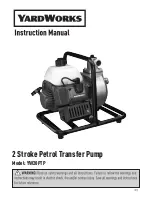
ENGLISH
16
(Filter for intake pipe)
1-
Filter body
2-
Narrow mesh filter
3-
Differential pressure gauge
4-
Perforated sheet
5-
Pump intake aperture
6. PROTECTIONS
6.1 Moving parts
In accordance with accident-prevention regulations, all moving parts (fans, couplings, etc.) must be accurately protected with special devices
(fan covers, coupling covers) before operating the pump
.
During pump operation, keep well away from the moving parts (shaft, fan, etc.) unless it is absolutely necessary, and only then wearing
suitable clothing as required by law, to avoid being caught
.
6.2 Noise level
The noise levels of pumps with standard supply motors are indicated in table 1 on page 91
.
Remember that, in cases where the LpA noise levels exceed 85 dB(A), suitable HEARING PROTECTION must be used in the place of
installation, as required by the regulations in force.
6.3 Hot and cold parts
As well as being at high temperature and high pressure, the fluid in the system may also be in the form of steam!
DANGER OF BURNING.
It may be dangerous even to touch the pump or parts of the system
.
If the hot or cold parts are a source of danger, they must be accurately protected to avoid contact with them
.
7. INSTALLATION
The pumps may contain small quantities of residual water from testing.
We advise flushing them briefly with clean water before their final installation
.
−
The electropump must be fitted in a well ventilated place, protected from unfavourable weather conditions and with an environment
temperature not exceeding 40°C.
Fig. A.
Electropumps with degree of protection IP55 may be installed in dusty and damp environments. If installed in the open, generally it is
not necessary to take any particular steps to protect them against unfavourable weather conditions.
−
The buyer is fully responsible for preparing the foundation. Metal foundations must be painted to avoid corrosion; they must be level
an sufficiently rigid to withstand any stress due to short circuits. Their dimensions must be calculated to avoid the occurrence of
vibrations due to resonance.
With concrete foundations, care must be taken to ensure that the concrete has set firmly and is completely dry before placing the unit
on it.
A firm anchoring of the feet of the pump/motor assembly on the base helps absorb any vibrations created by pump operation. Fig.
B
−
Ensure that the metal pipes do not transmit excess force to the pump apertures, so as to avoid causing deformations or breakages.
Fig. B.
Any expansion due to the heat of the pipes must be compensated with suitable precautions to avoid weighing down on the
pump. The flanges of the pipes must be parallel to those of the pump.
−
To reduce noise to a minimum it is advisable to fit vibration-damping couplings on the intake and delivery pipes and between the motor
feet and the foundation.
−
It is always good practice to place the pump as close as possible to the liquid to be pumped.
The internal diameter of the pipes
must never be smaller than that of the apertures of the pump. If the head at intake is negative, it is indispensable to fit a foot valve with
suitable characteristics at intake. Fig. C. For suction depths of over four metres or with long horizontal stretches it is advisable to use
an intake pipe with a diameter larger than that of the intake aperture of the pump.
Irregular passages between the diameters of the pipes and tight curves considerably increase load losses. Any passage from a pipe
with a small diameter to one with a larger diameter must be gradual. Usually the length of the passage cone must be 5 to 7 times the
difference in diameter.
Check accurately to ensure that the joins in the intake pipe do not allow air infiltrations.
Ensure that the gaskets between flanges and counterflanges are well centred so as not to create resistances to the flow in the pipes.
To prevent the formation of air pockets, the intake pipe must slope slightly upwards towards the pump.
Fig. C
If more than one pump is installed, each pump must have its own intake pipe. The only exception is the reserve pump (if envisaged)
which, as it starts up only in the case of breakdown of the main pump, ensures the operation of only one pump for each intake pipe.
−
Interception valves must be fitted upstream and downstream from the pump so as to avoid having to drain the system when carrying
out pump maintenance.
−
The pump must not be operated with the interception valves closed, as in these conditions there would be an increase in
the temperature of the liquid and the formation of vapour bubbles inside the pump, leading to mechanical damage. If there is
any possibility of the pump operating with the interception valves closed, provide a by-pass circuit or a drain leading to a liquid recovery
tank.
−
To guarantee good operation and maximum performance of the electropump, it is necessary to know the level of the N.P.S.H. (Net
Positive Suction Head) of the pump concerned, so as to determine the suction level Z1. The curves for the N.P.S.H. of the various
pumps are given on page 94-96. This calculation is important because it ensures that the pump can operate correctly without cavitation
5 1
2
4
3
















































